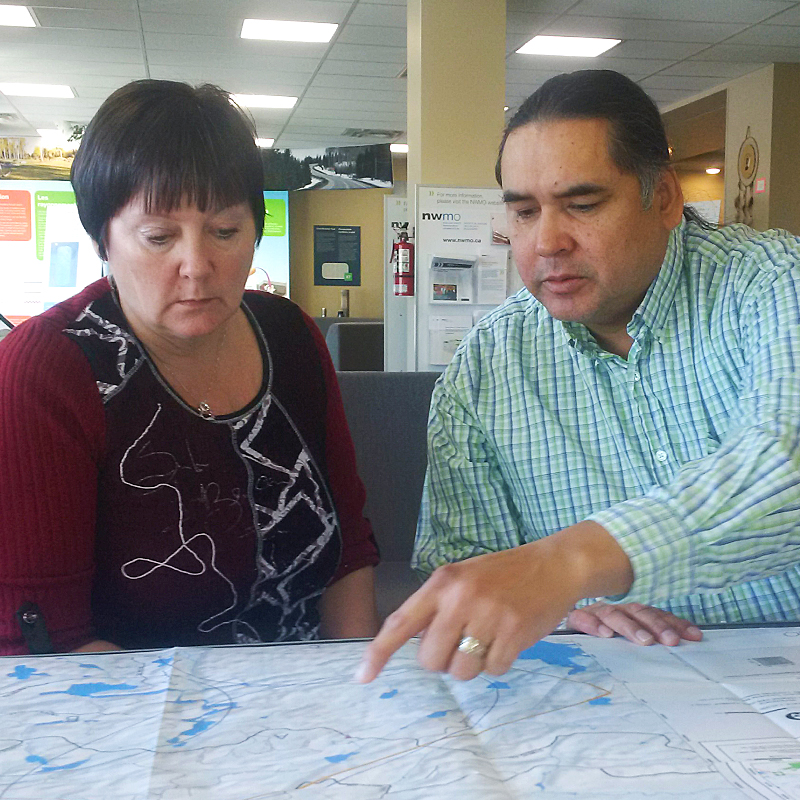Wabigoon Lake Ojibway Nation-Ignace area

Explore
Why the site was selected

Generations of possibilities

Committed to safety in the Wabigoon Lake Ojibway Nation-Ignace area
Frequently asked questions
View all FAQsWhat is used nuclear fuel?
Used nuclear fuel is a byproduct of electricity generation by nuclear power plants. Canadian nuclear power plants operating today are fuelled by uranium pellets that are sealed inside zirconium tubes and arranged into fuel bundles.
Once a fuel bundle has been used to generate electricity, it is highly radioactive and must be carefully managed for a very long period of time, essentially indefinitely.
Used nuclear fuel in Canada is safely managed on an interim basis in licensed facilities at nuclear reactor sites. The NWMO is responsible for its long-term management in a deep geological repository.
Can used nuclear fuel be transported safely?
The transportation of radioactive material is a well-established practice. Approximately one million packages of nuclear substances are transported in Canada every year. They move by land, air and sea, under strict regulation that ensures that they pose very little threat. As for used nuclear fuel specifically, Canada has proven, and continues to demonstrate, its ability to safely transport used fuel, with hundreds of shipments made since the 1960s. Other countries have shipped 20,000 shipments worldwide by road, rail and water over the past 50 years. There have been zero serious injuries, health effects or environmental consequences.
Are the storage containers tested to ensure they won't leak?
Yes. The repository storage containers are part of a series of engineered and natural barriers that will work together to contain and isolate used nuclear fuel in the deep geological repository. They are made of thick, solid steel and welded shut. The steel provides the mechanical strength to withstand the pressures of the overlying rock and future glaciations. The outermost layer of the container consists of corrosion-resistant copper coating.
The containers will undergo non-destructive examination using ultrasonic high-frequency sound waves that can characterize thickness and internal structure, as well as surface testing to ensure there are no flaws in the weld or copper coating, confirming there are no leaks.
Would earthquakes affect the repository?
Earthquakes are one of several factors we examined in the repository site evaluation process.
The repository will be located in an area where current and future earthquake (seismic) activity will not impact the safety of the repository during the operational phase or over the very long term. Even so, the repository will be designed to withstand large magnitude earthquakes.
Assessing the potential impact of earthquakes involves the following considerations:
- History of seismic activity in the area;
- Presence of major faults or fractures;
- Evidence of rock displacement along old faults;
- Groundwater chemistry that can provide evidence of stability over long periods; and
- Rock strength.
How will the NWMO protect farmland and agricultural lands?
The NWMO is using best environmental practices to ensure the project is implemented in a way that protects people, agricultural lands, watersheds and sensitive ecological environments.
We are partnering with landowners, conservation authorities and other interested organizations to lead baseline and research studies to understand the ecological systems in the area, including surface water, groundwater, soil, air, wetlands, animals and species at risk. These studies will inform our work as we mitigate or eliminate potential adverse impacts of the project using technologies and operational best practices.
There will be a continuous monitoring of the natural environment throughout all phases of the project, including open and transparent reporting and information sharing.
This project will also be subject to a thorough regulatory review process, including an environmental assessment and a licensing review, to ensure that it is implemented in a manner that protects people and the environment. In our planning timelines, we currently anticipate that the regulatory review process will take approximately 10 years.
